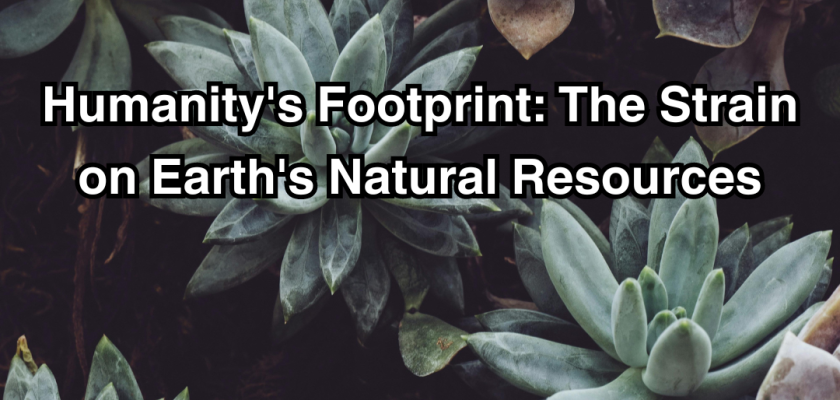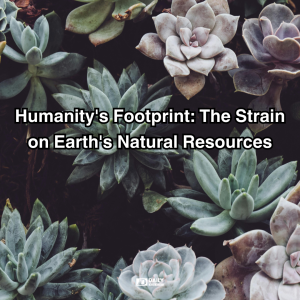Introduction:
Humanity’s rapid growth and relentless pursuit of progress have left an indelible mark on Earth’s natural resources. As the global population surges towards unprecedented numbers, the demand for resources such as water, fossil fuels, and arable land intensifies, pushing ecosystems to their limits. This unsustainable exploitation leads to deforestation, pollution, and climate change, threatening biodiversity and the very foundation of life. Understanding and addressing the adverse effects of our footprint is crucial for forging a sustainable future. This exploration delves into the intricate relationship between human activities and natural resources, emphasizing the urgent need for responsible stewardship.
As humanity continues to grow and develop, the strain on Earth’s natural resources becomes increasingly evident. The following discussion delves into ten critical points illustrating how human activities are impacting the planet’s resources.
Overpopulation:
The global population has recently surpassed 8 billion, creating an unprecedented demand for resources such as food, water, and energy. This growth puts enormous pressure on natural resources and ecosystems. As urban areas expand to accommodate more people, arable land is often converted into residential and industrial zones, reducing the land available for agriculture—the increased demand for food drives intensive farming practices that can deplete soil nutrients and lead to deforestation. Overpopulation also exacerbates other environmental issues, including pollution and waste generation, as more people produce more waste and require more industrial goods.
Deforestation:
Deforestation is the large-scale clearing of forests, primarily for agricultural expansion, logging, and urban development. Forests play a crucial role in regulating the Earth’s climate by absorbing carbon dioxide during photosynthesis. When forests are cut down, the carbon stored in trees is released back into the atmosphere, contributing to global warming. Additionally, deforestation leads to habitat loss, which endangers countless species and disrupts entire ecosystems. Tropical rainforests, often referred to as the “lungs of the Earth,” are particularly affected, with significant portions being destroyed annually. The loss of forests also affects indigenous communities that rely on these ecosystems for their livelihoods.
Water Scarcity:
Freshwater is a finite resource essential for drinking, agriculture, and industrial processes. However, over-extraction from rivers, lakes, and aquifers has led to severe water shortages in many parts of the world. Agricultural activities consume about 70% of global freshwater resources, often in inefficient ways that lead to significant wastage. Industrial processes and urban consumption further strain water supplies. Climate change exacerbates water scarcity by altering precipitation patterns, leading to prolonged droughts in some regions and floods in others. As water becomes scarcer, conflicts over access to this vital resource are likely to increase, affecting both human populations and natural ecosystems.
Climate Change:
Climate change is primarily driven by the accumulation of greenhouse gases, such as carbon dioxide and methane, in the atmosphere. These gases trap heat, leading to global warming. Human activities, including the burning of fossil fuels, deforestation, and industrial processes, are significant sources of these emissions. The consequences of climate change are far-reaching and include rising sea levels, more frequent and severe weather events, shifting climate zones, and the loss of polar ice. These changes threaten biodiversity, disrupt agricultural productivity, and pose risks to human health and safety. Mitigating climate change requires a concerted global effort to reduce greenhouse gas emissions and transition to sustainable energy sources.
Pollution:
Pollution affects air, water, and soil quality, posing serious risks to human health and the environment. Industrial activities release pollutants, such as heavy metals, chemicals, and particulates, into the atmosphere, leading to air quality issues and respiratory problems. Water pollution from industrial discharges, agricultural runoff, and untreated sewage contaminates freshwater resources, affecting aquatic life and making water unsafe for human consumption. Soil pollution, often caused by pesticides and industrial waste, degrades land quality and reduces agricultural productivity. The pervasive presence of plastic pollution, particularly in oceans, harms marine life and disrupts ecosystems. Reducing pollution requires stringent regulations, sustainable practices, and increased public awareness.
Loss of Biodiversity:
Biodiversity is crucial for ecosystem stability and resilience. However, human activities such as habitat destruction, pollution, and climate change are driving species to extinction at an alarming rate. The loss of biodiversity reduces the ability of ecosystems to provide essential services, such as pollination, water purification, and climate regulation. It also diminishes genetic diversity, which is vital for species to adapt to changing environmental conditions. Protecting biodiversity involves conserving natural habitats, implementing sustainable land-use practices, and addressing the root causes of biodiversity loss, including climate change and pollution.
Soil Degradation:
Soil degradation is a process that reduces the fertility and productivity of soil, making it less capable of supporting plant life. This can result from erosion, nutrient depletion, salinization, and contamination. Intensive agricultural practices, such as monocropping and overuse of chemical fertilizers and pesticides, contribute significantly to soil degradation. Deforestation and overgrazing also lead to soil erosion, where the topsoil is washed or blown away, leaving the land barren. Soil degradation not only threatens food security by reducing crop yields but also contributes to desertification and the loss of arable land. Sustainable farming practices, soil conservation techniques, and reforestation efforts are crucial to combating soil degradation.
Overfishing:
Overfishing occurs when fish are harvested at a rate faster than they can reproduce, leading to the depletion of fish stocks. This practice has significant ecological and economic impacts. Many fish species are now endangered, and the loss of top predators can disrupt marine food webs, leading to the overpopulation of other species and further ecological imbalance. Coastal communities that rely on fishing for their livelihoods are also affected, facing reduced catches and economic hardship. Sustainable fishing practices, including quotas, marine protected areas, and aquaculture, are essential to ensure the long-term viability of fish populations and the health of marine ecosystems.
Waste Generation:
The modern consumer culture, characterized by high levels of consumption and the proliferation of single-use products, has led to an explosion in waste generation. Landfills are filling up rapidly, and waste management systems in many areas are inadequate to handle the volume of waste produced. Plastic waste is particularly problematic due to its durability and prevalence in packaging and consumer goods. Improper disposal of waste leads to environmental pollution, harming wildlife and human health. Recycling, waste reduction initiatives, and the development of biodegradable materials are critical components of a sustainable waste management strategy.
Resource Inequality:
Resource inequality refers to the uneven distribution of natural resources and the benefits derived from them. Wealthier nations and individuals tend to consume disproportionately more resources, while poorer regions often bear the brunt of environmental degradation and resource scarcity. This disparity exacerbates social and economic inequalities, leading to conflicts over resources and impeding efforts to achieve sustainable development. Addressing resource inequality requires fairer distribution mechanisms, international cooperation, and policies that promote equitable access to resources while protecting the environment.
Conclusion
Humanity’s footprint on Earth’s natural resources is profound and multifaceted. Overpopulation, deforestation, water scarcity, climate change, pollution, loss of biodiversity, soil degradation, overfishing, waste generation, and resource inequality are interlinked issues that collectively strain the planet’s ability to sustain life. Addressing these challenges requires a holistic approach that incorporates sustainable practices, technological innovations, policy reforms, and global cooperation. By understanding and mitigating the adverse effects of our actions, we can work towards a more sustainable and equitable future for all.


